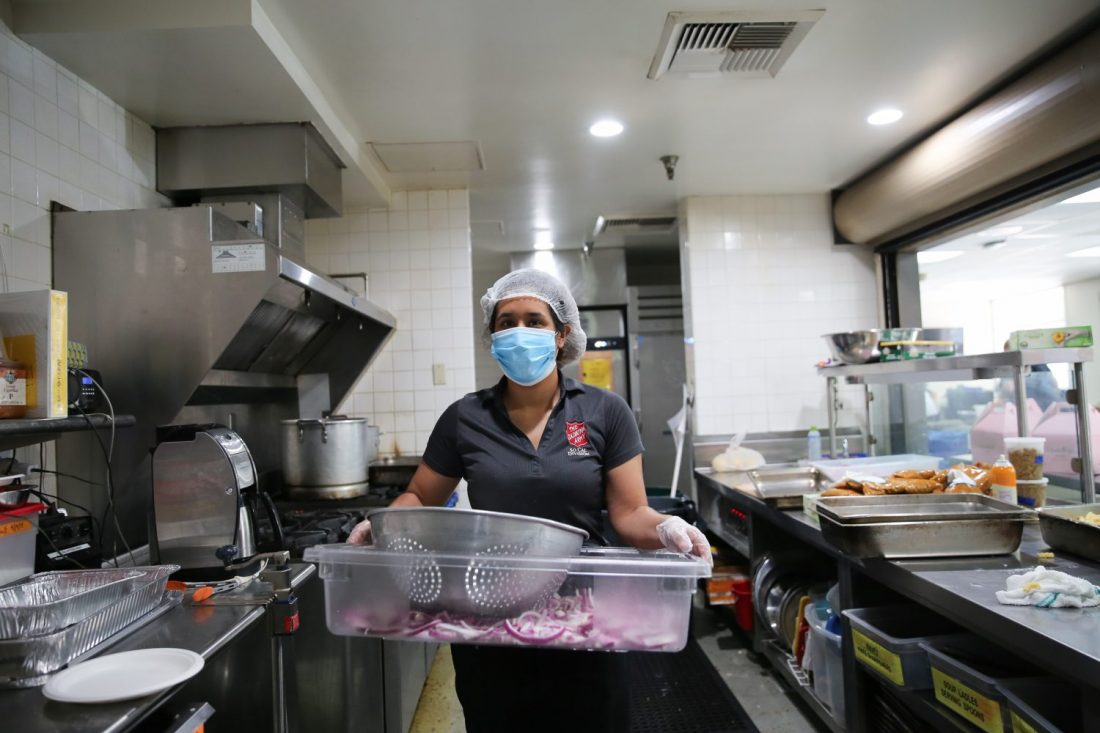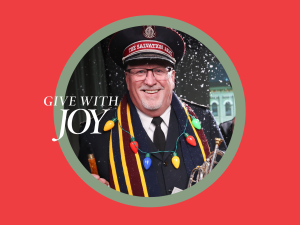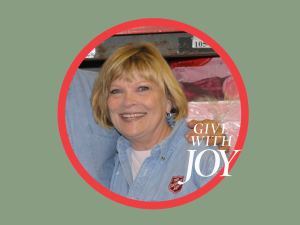At this point, I think it’s safe to say no one has gone untouched by this crisis. The outbreak of a respiratory illness caused by a new coronavirus—called COVID-19—was first declared a pandemic by the World Health Organization on March 11, and it has steadily rolled into more than 200 countries and territories around the world.
The first case appeared in the U.S. in late January 2020, with America now having the most confirmed active cases in the world.
It’s invaded every aspect of life as we know it with widespread “stay at home” orders shuttering businesses, closing schools and canceling events of all kinds. I recorded this podcast episode in a closet at home, rather than a studio, while my 2-year-old and 2-month-old nap nearby. These are strange and scary days.
And while things have slowed down in many areas, for The Salvation Army everything has ramped up.
The Salvation Army is in emergency response mode across the country. All Salvation Army facilities are available for response efforts and all Salvation Army officers (or pastors) and personnel are assigned to emergency response, providing emergency food programs and emergency shelter services in just about every zip code.
You may remember back in episode 21 of this podcast, I set out to provide as complete an overview as possible on the extensive work of The Salvation Army and its six key pillars of service as the organization annually helps more than 23 million Americans overcome poverty, addiction and economic hardships through a range of social services.
With this episode, we’re kicking off a new series, called “meet the helpers.” In the episodes to come, I’ll be introducing you to those on the front lines of this crisis, those working every day to meet human need—now more than ever.
Let’s review:
To recap episode 21, those six key pillars of Salvation Army service include:
#1 The Salvation Army is there for those with nowhere to go.
#2 The Salvation Army is there for the hungry.
#3 The Salvation Army is there when disaster strikes.
#4 The Salvation Army is there for children.
#5 The Salvation Army is there for seniors.
#6 The Salvation Army is there for those in need of recovery.
Plus—The Salvation Army is a church.
In fact, the mission statement says this: “The Salvation Army, an international movement, is an evangelical part of the universal Christian Church. Its message is based on the Bible. Its ministry is motivated by the love of God. Its mission is to preach the gospel of Jesus Christ and to meet human needs in His name without discrimination.”
This is a glimpse into the emergency disaster response effort happening in each of these pillars.
1. The Salvation Army is there for those with nowhere to go.
Across the U.S., The Salvation Army provides a safe place to sleep for nearly 30,000 people every night in its group homes, emergency shelters and transitional living centers. And in the western U.S., The Salvation Army has committed to doubling its impact on homelessness (hear more about that in episode 6).
As COVID-19 put those experiencing homelessness at a heightened risk, right away The Salvation Army offered all of its buildings and facilities to local governments for use as shelters and other purposes.
In Orange County, California, a pair of thrift stores are opening as emergency shelters after being cleared out for a new purpose.
In the Pacific Northwest, with the city of Seattle, the Army is putting up a temporary 200-bed modular structure at the Memorial Stadium at the Seattle Center.
In Los Angeles County, The Salvation Army is managing 14 homeless shelters and opening a minimum of five additional shelters.
In Las Vegas, the Army is overseeing four shelters: an emergency shelter, hostel, LGBTQ safety dorm and shelter for quarantined individuals.
And the Army is working to prevent homelessness by providing rent and utility assistance.
In Colorado and the surrounding states, The Salvation Army has received about 1,100 calls a day of those looking for assistance—a number it would usually receive in a month. Many of the calls have been requests for rent assistance, and the Army currently has over $1 million in pending requests.
2. The Salvation Army is there for the hungry.
The Salvation Army provides an average of 156,000 meals every single day across the country—feeding anyone in need. As the coronavirus pandemic has taken hold of communities, however, the way The Salvation Army distributes food is changing.
Corps are working diligently to pack food boxes and bags for those facing food insecurity, including seniors isolated during the crisis and kids no longer receiving regular meals because of school closures. The method might look different, but the message remains: The Salvation Army is feeding the hungry.
It is delivering meals to families, like in Avondale, Arizona, where the school is offering both breakfast and lunch, but each child has to be present at the school two separate times a day to get the food. With parents working that means those kids would be walking back and forth twice a day. So the Estrella Mountain Corps is focusing on meal delivery to families who cannot get to the schools for pick up. They delivered more than 300 meals in just the first day kids in the area were out of school.
In other locations, client choice food pantries are shifting to pre-packed boxes to limit the handling of food or from congregate meals in the main dining area to room-to-room delivery as at the Phoenix Emergency Family Shelter, where they are also doing case management by phone instead of face-to-face.
In Bakersfield, California, The Salvation Army partnered with Aspiranet, a foster agency, to provide daily food and supplies to 71 individuals, including 15 parenting teens.
In Santa Cruz, California, where the Army shelters more than 120 people a night, emergency food bags continue to be available to the general public and the weekly fresh produce is still being distributed—though now it’s pre-bagged rather than farmer’s market style.
When the Ray and Joan Kroc Corps Community Center in Hawaii received a donation of some 7,000 eggs Eggs Hawaii Inc.. the center held two drive-through distribution days for community members to receive a free tray of eggs.
And in Aurora, Colorado, The Salvation Army regularly partners with the Aurora Police Department’s Crisis Response Team, which works with people in the community experiencing mental health problems. Typically, officers will stop at the corps to pick up a food box for an individual or family in need, however as COVID-19 has spread, the police officers have seen an increase in need among their clients.
Specifically, they’ve seen an increase in suicide attempts as the pandemic causes many people anxiety and fear. In response, The Salvation Army provided the team with hygiene supplies and food boxes to keep in their cars and have readily available to those in need.
Next, because everything falls under disaster response right now, we’ll skip to pillar 4. The Salvation Army is there for children.
For many kids throughout the U.S., The Salvation Army is the reason they are able to participate in sports, arts and music programs through more than 400 after-school programs.
Now, during the COVID-19 pandemic, many of the ways the Army typically serves children are not possible due to CDC recommendations and social distancing. Still, the Army has modified the way it cares for youth to make sure they are fed, active and connected.
In Roseville, California, The Salvation Army is packing weekly activity bags. It was originally offered to about 30 of the corps’ regular program participants, but after opening it to the wider community, the list grew to include 200 children. Volunteers are delivering the weekly bags to kids at home, with each week featuring a different theme.
Similar, so called “isolation kits,” are available in many locations offering drive-through food services with activities and toys for kids in the vehicles.
In the Ray and Joan Kroc Corps Community Centers—normally beacons of fun and fitness (see episode 13)—The Salvation Army is now caring for children of first responders and healthcare workers—from San Francisco, to Couer d’ Alene, Idaho, to Suisun City, California.
5. The Salvation Army is there for seniors.
Seniors have always been a priority to The Salvation Army, and as this age group is among those considered at the highest risk of contracting COVID-19, the Army has modified the way it meets needs and shows love to seniors.
In Long Beach, California, The Salvation Army got a call before the state’s Safer at Home orders from a senior who comes to its programs who couldn’t leave home and didn’t have enough food. The corps promised to deliver a food box. That person called her neighbors, and pretty soon the word got out The Salvation Army would deliver food. On the first day, the corps delivered eight food boxes.
By the end of the week, the Army delivered 309 food boxes and food bags to seniors, families and individuals in the Long Beach community, an effort that served more than 1,200 people. And that was just the first week.
Everywhere, the Army has stepped up its food box delivery efforts for seniors, and has modified its group meals to be served in to-go containers that are to be eaten privately.
The Salvation Army in Salinas, California, was concerned for those who normally attend its senior drop-in center, and launched a senior meals drive-through. It also started delivering meals, via volunteers, to 35 units at a mobile home park.
One senior who lives in the mobile home park wrote a card that said: “Thank you so much for the food. You will never know what it means. After paying all my bills for March, I had $9.59 left for tithes to my church, food and gas for my car. To say I had nothing to eat is an understatement. My prayer is for God to return it to you 10-fold.”
In addition to providing food, The Salvation Army has delivered other items to seniors, including water, paper products and cleaning supplies where it is needed.
Beyond practical needs, the Army is also performing wellness checks by phone and email, teaching social media skills to help them stay connected, offering online shopping assistance and simply someone to talk to.
For the roughly 3,000 senior residents of apartment-style communities called Silvercrests in the West, The Salvation Army mailed a postcard to each one with a phone number—what’s been dubbed the “Silverline”—for residents to call for emotional and spiritual support.
6. The Salvation Army is there for those in need of recovery.
Each year, The Salvation Army helps to equip over 150,000 people to combat addiction through counseling, life-skills development, work therapy and spiritual direction in more than 130 residential treatment facilities across the country.
In these Adult Rehabilitation Centers (or ARCs), The Salvation Army works to help people find not only sobriety, but recovery. Participants engage in work therapy, helping to process the donated goods for sale in stores or to be recycled. The sales from the Family Stores help fund the recovery programs.
Due to COVID-19, Salvation Army Family Stores are temporarily closed for shopping. The ARCs are, in effect, closed campuses to protect the men and women who live there. But the ministry continues.
In each center, participants are being engaged in service, helping to pack food boxes and provide janitorial assistance and other services as corps locations are stretched thin. Drivers have helped pick up large donations, including a big supply of toilet paper in the Porter Ranch, California, area.
Though shopping is suspended, staff remain onsite at Family Stores to accept donations of gently used household goods, appliances, furniture, clothing and accessories. These goods will help ensure The Salvation Army can continue drug and alcohol rehabilitation programming in the future.
And while all ARCs are closed campuses during COVID-19, administrators and beneficiaries have kept spirits up and maintained sobriety by avoiding idleness. Throughout the West’s 18 centers, beneficiaries continue holding Bible studies and have fun through creative quarantine ideas, from themed meal nights to singing karaoke, playing games and holding go-cart races in the parking lot.
Finally, worship continues.
Nearly 1,200 Salvation Army locations across the U.S. offer worship services every Sunday morning. And while COVID-19 has temporarily changed the way in which we worship, the Army has adapted its ministry to invite people in from home.
Services are being conducted via Facebook Live—and many locations are seeing a continued uptick in attendees. Leaders are also getting creative in how they connect with people. One choir leader in Pasadena, California, used what would have been the weekly rehearsal time to go live singing hymns. A corps officer, or pastor, in Auburn, California, recorded a Bible storytime for kids. And in Santa Cruz, California, the officers set up a prayer hotline using Google Voice.
An online Easter service welcomed worshippers from around the world, with Territorial Commander Commissioner Kenneth G. Hodder bringing the message.
He reminded listeners of Paul’s words in Romans 8:31-32: “If God is for us, who can be against us? He who did not spare his own Son, but gave him up for us all—how will he not also, along with him, graciously give us all things?”
As Hodder said, “The events we see unfolding around the world today make it all the more important that we hold on to hope, a hope built on trust that is in turn grounded in our remembrance of what Christ has already done.”
He asked: “Why should we not now, even when the wind and the waves seem ready to swamp us, trust him all the more to get us safely home?”
It’s a belief we’re holding on to these days because in The Salvation Army, we believe that hope is greater than fear.
In the midst of COVID-19, if you need help or you can give help, please visit westernusa.salvationarmy.org. And stay tuned in the weeks ahead to meet the helpers engaged in these efforts on the frontlines.
Until then, keep on doing good.
Do Good:
- If you’d like to make a monetary donation, please click here to make a gift.
- Text ‘GIVE’ to 52000 to make a $10 donation to The Salvation Army. This will automatically add a one-time donation to your next mobile phone bill.
- For information about volunteering, please visit volunteer.usawest.org.
- To learn more about how to support The Salvation Army’s relief efforts, please click here.













Comments are closed.